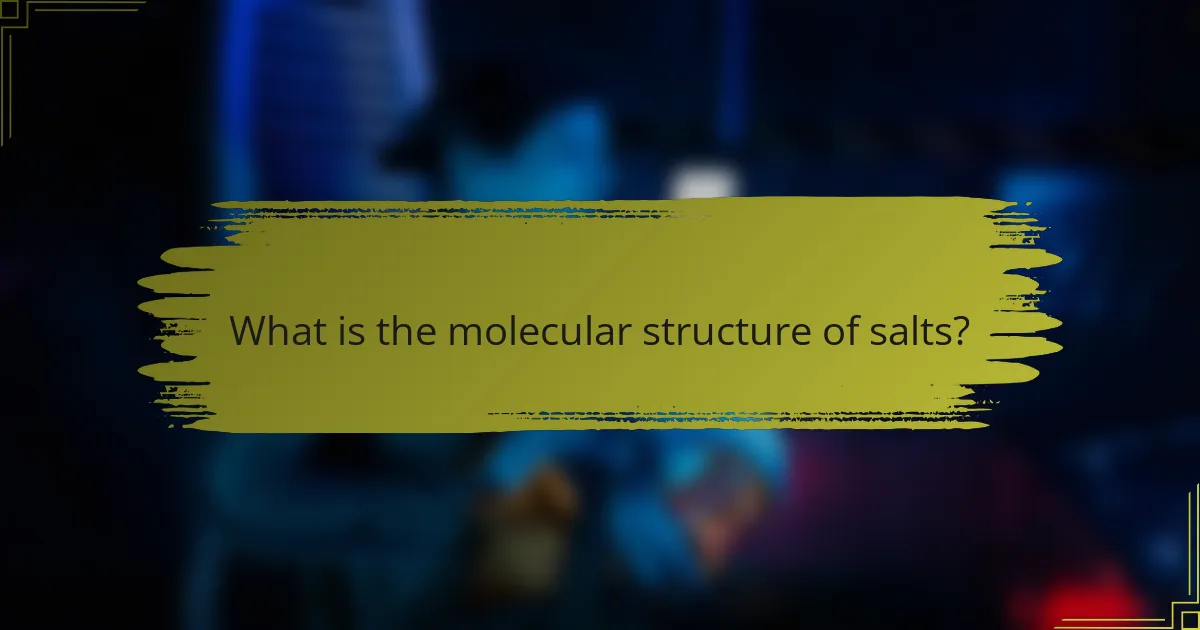
What is the molecular structure of salts?
Salts consist of ionic compounds formed by the electrostatic attraction between cations and anions. The molecular structure of salts is characterized by a repeating lattice arrangement of ions. In this structure, each ion is surrounded by ions of opposite charge. This arrangement maximizes the attractive forces and minimizes repulsion. The most common form of salt is sodium chloride (NaCl). In NaCl, sodium ions (Na+) and chloride ions (Cl-) alternate in a three-dimensional grid. The ionic bond between these ions is strong, resulting in high melting and boiling points. The crystalline structure of salts contributes to their distinct geometric shapes.
How do ionic bonds form in salts?
Ionic bonds form in salts through the transfer of electrons between atoms. Typically, this process occurs between a metal and a non-metal. The metal atom loses one or more electrons, becoming a positively charged cation. Conversely, the non-metal atom gains those electrons, becoming a negatively charged anion. The electrostatic attraction between these oppositely charged ions creates the ionic bond. This bond results in the formation of a stable ionic compound, such as sodium chloride (table salt). The strong ionic bonds contribute to the high melting and boiling points of salts.
What are the key characteristics of ionic bonds?
Ionic bonds are formed through the electrostatic attraction between oppositely charged ions. These bonds typically occur between metals and nonmetals. Metals lose electrons to become positively charged cations. Nonmetals gain electrons to become negatively charged anions. Ionic compounds generally have high melting and boiling points due to strong ionic interactions. They often form crystalline structures, which are stable and organized. Ionic compounds conduct electricity when dissolved in water or molten. This is because the ions are free to move in these states. These characteristics distinguish ionic bonds from other types of chemical bonds.
How do ionic bonds influence the properties of salts?
Ionic bonds significantly influence the properties of salts. These bonds result from the electrostatic attraction between positively charged cations and negatively charged anions. This strong attraction leads to the formation of a crystalline lattice structure in salts. The lattice structure contributes to the high melting and boiling points of ionic compounds. Additionally, ionic bonds affect the solubility of salts in water. Many ionic salts dissolve in water due to the interaction between water molecules and the ions. The solubility varies based on the strength of the ionic bonds and the hydration energy of the ions. For instance, sodium chloride is highly soluble in water, while barium sulfate is not. Overall, ionic bonds are fundamental in determining the physical and chemical properties of salts.
What are the different types of salts?
There are several types of salts, primarily categorized based on their composition and properties. Common table salt is sodium chloride (NaCl). Other salts include potassium chloride (KCl) and magnesium sulfate (MgSO4). Salts can also be classified as acidic, basic, or neutral. Acidic salts, like ammonium chloride (NH4Cl), result from the reaction of a strong acid with a weak base. Basic salts, such as sodium bicarbonate (NaHCO3), form from a weak acid and a strong base. Neutral salts, like NaCl, arise from the reaction of a strong acid and a strong base. Additionally, salts can be classified by their solubility, with soluble salts dissolving in water and insoluble salts remaining undissolved. This classification helps in understanding their applications and behavior in different environments.
How are salts classified based on their composition?
Salts are classified based on their composition into two main categories: simple salts and complex salts. Simple salts consist of a single cation and a single anion, such as sodium chloride (NaCl). Complex salts contain more than one type of cation or anion, like potassium aluminum sulfate (KAl(SO4)2·12H2O). This classification is fundamental in chemistry for understanding the properties and behaviors of different salts. Simple salts generally exhibit straightforward ionic bonding. Complex salts may display more intricate interactions due to their varied components. Understanding these classifications aids in predicting the solubility and reactivity of salts in various environments.
What role do cations and anions play in salt classification?
Cations and anions are essential in classifying salts. Cations are positively charged ions, while anions are negatively charged ions. The combination of these ions forms various types of salts. For example, sodium chloride consists of sodium cations and chloride anions. Salts are classified based on the nature of their cations and anions. This classification can include categories like simple salts, double salts, and complex salts. The specific properties of cations and anions influence the salt’s solubility and stability. Additionally, the size and charge of these ions affect the crystal structure of the salt. Therefore, understanding cations and anions is crucial for identifying and categorizing different salts.
What is the significance of crystalline forms in salts?
Crystalline forms in salts are significant because they determine the physical properties of the salt. The arrangement of ions in a crystal lattice affects solubility, melting point, and stability. For example, sodium chloride forms a cubic crystal structure, leading to its high solubility in water. In contrast, calcium carbonate has a different crystalline form, resulting in lower solubility. The specific crystalline structure influences how salts interact with solvents and other substances. Additionally, these forms can affect the salt’s reactivity and applications in various industries. Understanding crystalline forms is essential for predicting behavior in chemical processes.
How do different crystalline structures affect salt properties?
Different crystalline structures significantly affect salt properties. The arrangement of ions in a crystal lattice influences solubility, melting point, and hardness. For example, sodium chloride forms a cubic structure, leading to high solubility in water. In contrast, calcium carbonate has a more complex structure, resulting in lower solubility. Additionally, the strength of ionic bonds varies with crystal geometry, affecting melting points. For instance, salts with tightly packed structures generally have higher melting points. Variations in crystalline forms also impact mechanical properties, such as brittleness and cleavage. Thus, the crystalline structure is crucial in determining the physical and chemical behavior of salts.
What are the common types of crystalline forms found in salts?
The common types of crystalline forms found in salts include cubic, hexagonal, and orthorhombic structures. Cubic crystals are characterized by equal edge lengths and right angles. Sodium chloride is a classic example of cubic crystals. Hexagonal crystals have a six-sided symmetry and are seen in salts like zinc sulfide. Orthorhombic crystals feature three unequal axes that intersect at right angles. Examples include potassium nitrate. These forms arise from the arrangement of ions in a lattice structure, influenced by ionic bonding.

How does solubility relate to the molecular structure of salts?
Solubility is directly influenced by the molecular structure of salts. The ionic bonds in salts determine their solubility in water. Stronger ionic bonds result in lower solubility. This is due to the energy required to break these bonds during dissolution. Salts with smaller ions and higher charges tend to have higher lattice energies. High lattice energy often leads to decreased solubility. Conversely, salts with larger ions or lower charges generally dissolve more readily. The arrangement of ions in the crystalline structure also affects solubility. A less compact structure can facilitate easier interaction with water molecules.
What factors influence the solubility of salts?
The solubility of salts is influenced by several factors. Temperature is a key factor; generally, solubility increases with rising temperature for most salts. Pressure also affects solubility, particularly for gases dissolved in liquids. The nature of the solvent plays a crucial role; polar solvents usually dissolve ionic salts better than non-polar solvents. Ionic strength of the solution can impact solubility; higher ionic strength often decreases solubility due to the common ion effect. The specific ions involved also matter; some ions have higher solubility due to lower lattice energy. Lastly, pH can influence solubility for salts that react with acids or bases, altering their dissociation.
How do temperature and pressure affect salt solubility?
Temperature generally increases salt solubility, while pressure has a minimal effect. Higher temperatures provide more energy, allowing salt ions to separate and dissolve more effectively. For example, in water, solubility of common salts like sodium chloride increases significantly with temperature. Pressure primarily influences the solubility of gases rather than solids like salt. According to the principles of thermodynamics, increased pressure has little impact on solid solubility in liquids. Thus, temperature is the key factor affecting salt solubility, with higher temperatures leading to greater solubility.
What is the role of ionic strength in solubility?
Ionic strength affects the solubility of salts in solution. It influences the interactions between ions and water molecules. Higher ionic strength generally increases solubility for salts that dissociate into ions. This is due to the shielding effect, where increased ions in solution reduce the electrostatic attraction between the ions of the salt.
For example, in solutions with higher ionic strength, the solubility of calcium sulfate increases. This phenomenon is supported by the Debye-Hückel theory, which describes how ionic strength impacts activity coefficients. As ionic strength rises, the activity coefficients of ions decrease, leading to increased solubility. Thus, ionic strength plays a crucial role in determining the solubility of ionic compounds in aqueous solutions.
What are the implications of salt solubility in various applications?
Salt solubility affects various applications significantly. In agriculture, soluble salts enhance nutrient availability in soil. This improves crop yield and quality. In industrial processes, salt solubility is crucial for chemical reactions. It influences product formation and efficiency. In pharmaceuticals, solubility determines drug absorption and effectiveness. Higher solubility often leads to better therapeutic outcomes. In food preservation, salt solubility impacts flavor and safety. Soluble salts inhibit microbial growth, extending shelf life. Overall, understanding salt solubility is vital for optimizing these applications.
How does solubility impact agricultural practices?
Solubility significantly impacts agricultural practices by influencing nutrient availability in soil. Soluble nutrients are readily absorbed by plants, promoting healthy growth. For instance, nitrogen, phosphorus, and potassium are vital macronutrients that must be soluble for effective uptake. Soil pH also affects solubility; certain nutrients become less available in acidic or alkaline conditions. Additionally, high solubility can lead to nutrient leaching, reducing soil fertility over time. Conversely, low solubility may result in nutrient deficiency, hindering crop yields. Understanding solubility helps farmers tailor fertilization strategies for optimal plant health.
What are the effects of salt solubility in industrial processes?
Salt solubility significantly impacts industrial processes. It influences the efficiency of chemical reactions. High solubility allows for better ion availability. This enhances reaction rates and product yields. Conversely, low solubility can lead to precipitation issues. Precipitation can clog equipment and disrupt processes. Additionally, solubility affects the transport of ions in solutions. This is crucial in processes like electrolysis and crystallization. Overall, understanding salt solubility is essential for optimizing industrial operations.

What are the practical considerations regarding the molecular structure of salts?
The molecular structure of salts involves ionic bonds that create a lattice arrangement. This structure influences the physical properties of salts, such as melting and boiling points. Salts typically have high melting points due to the strong electrostatic forces between ions. The crystalline form of salts affects their solubility in water. Salts with smaller ions or higher charges often dissolve more readily. The arrangement of ions in the crystal lattice can also determine the salt’s hardness and brittleness. Understanding these factors is crucial for applications in chemistry and materials science.
How can understanding salt structure improve everyday applications?
Understanding salt structure can enhance various everyday applications. Knowledge of ionic bonds allows for better formulation of fertilizers. This can lead to improved nutrient delivery in agriculture. Understanding crystalline forms aids in the production of pharmaceuticals. This ensures optimal solubility and bioavailability of medications. Insights into salt solubility can improve food preservation techniques. This helps in extending shelf life and maintaining flavor. Additionally, salt structure knowledge can enhance water treatment processes. This leads to more effective removal of contaminants. Overall, these applications demonstrate the practical benefits of understanding salt structure.
What tips can enhance the effective use of salts in cooking?
Use salts judiciously to enhance flavor without overwhelming dishes. Start with small amounts and adjust as needed. Consider the type of salt used; different salts have varying intensities. For instance, kosher salt is less salty by volume than table salt. Incorporate salt at various stages of cooking for layered flavors. Adding salt early can enhance the overall taste, while finishing with a sprinkle can provide a burst of flavor. Use salt to draw out moisture from ingredients, like vegetables, to intensify their flavor. Remember that salt enhances sweetness, so it can be beneficial in desserts. Always taste as you go to achieve the desired flavor profile.
How can knowledge of salt solubility aid in water treatment processes?
Knowledge of salt solubility is crucial in water treatment processes. It helps determine which salts can effectively dissolve in water, affecting treatment efficiency. High solubility salts can be removed easily through various methods. For instance, understanding solubility aids in selecting appropriate chemical agents for coagulation and flocculation. This knowledge also informs decisions on ion exchange processes. Specific salts may be used to target contaminants based on their solubility profiles. For example, calcium sulfate has low solubility, making it useful in reducing hardness in water. Additionally, the solubility of salts can impact the formation of precipitates, influencing overall water quality.
The primary entity of this article is the molecular structure of salts, which are ionic compounds formed through the electrostatic attraction between cations and anions. The article explores the characteristics of ionic bonds, the formation of crystalline structures, and the factors influencing salt solubility. Key topics include the types of salts, their classification based on composition, and the implications of solubility in various applications such as agriculture and industrial processes. Additionally, the article discusses how understanding salt structure can improve practical uses in cooking and water treatment.
